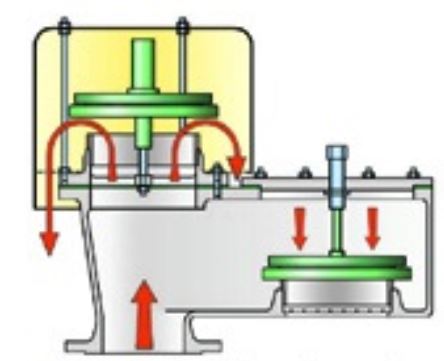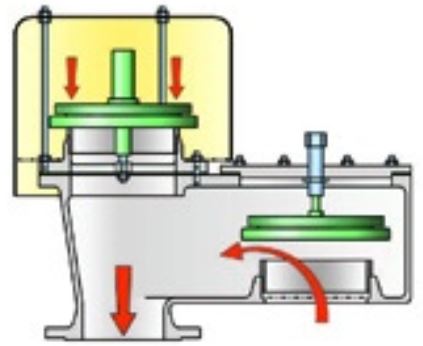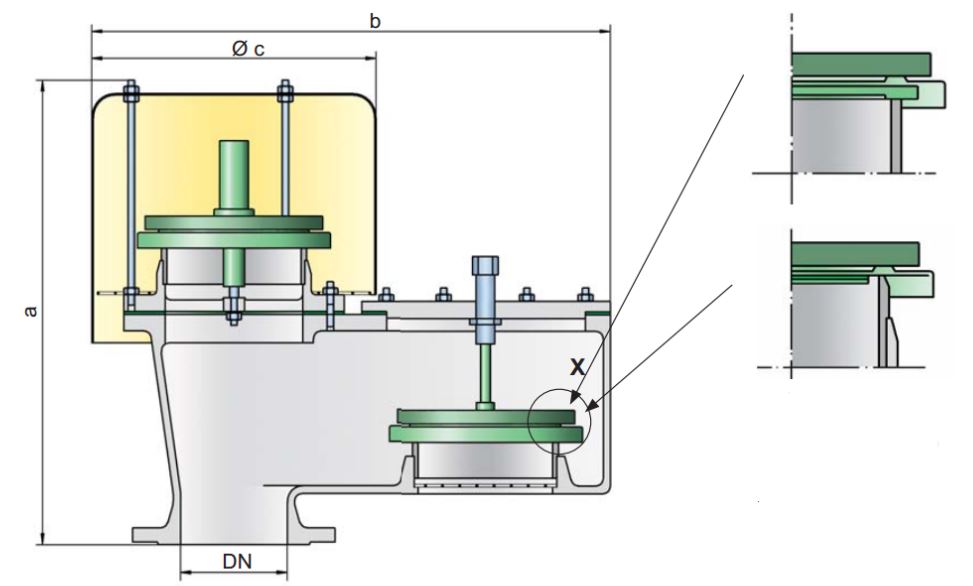1. Purpose of Pressure/Vacuum Relief Valves
2. How Pressure/Vacuum Relief Valves Function
3. Advantages of Pressure/Vacuum Relief Valve
Purpose of Pressure/Vacuum Relief Valve
In reality, properly sized opening on the tank roof protects the tank from rupture or imploading. However, it constantly outbreath and inbreath and during outbreathing cycle it losses the vapour to atmosphere and possesses constant fire hazard. This can be prevented by installation of pressure/vacuum relief valve. Cost of loss of vapour totally out weighs the cost of breather valve.
a) Calculating the tank content loss during outbreathing
– 20 feet dia and above
Ly = (TPY/1000) X (P/(14.7 – P))68 D 1.73 H 0.51 T 0.50 FP
Ly = The outbreathing loss in barrels per year
TPY = Turn overs per year
P = The true vapour pressure at bulk liquid temperature in Lbs/in2 abs
D = Tank diameter in feet
H = The average outage in feet
T = Average daily ambient temperature change
FP = Paint Factor
– Small dia tanks
Ly = (TPY/1000) X (P/(14.7-P)) 68 D 1.73 H 0.51 T 0.50 FP C
b) API’s estimated breathing loss table
| Tank Dia x Ht in feet | Nominal Tank Capacity barrels |
Breathing Loss |
BBLS/Year saved using Pr Relief Valve | |
| Estimated losses with Pressure Relief Valve | Estimated losses with open vent | |||
|
30’ x 40’ |
5000 |
154 |
235 |
81 |
|
42.5’ x 40’ |
10,000 |
297 |
441 |
144 |
|
60’ x 30’ |
20,000 |
570 |
825 |
255 |
|
100’ x 40’ |
55,000 |
1382 |
2000 |
618 |
Due to the above statement breather valve is also termed as conservation vent valve.
c) Basic fire protection mode with usage of pressure / vacuum relief valve
– Observes close tank principle within set pressures on pressure and vacuum side hence vapours have no access to external fire source and to allow combustion
– Breather valve discharge to atmosphere is with positive pressure and the velocity of the relieving vapour is higher than flame speed hence protects the tank content from external fire source
– Over rich vapour mixture within tank due to equilibrium being reached in a closed tank, the vapours are too rich to burn. However when emptying the tank due to inbreathing of air and oxygen in air, the vapour mixture is susceptible to ignite hence flame arrestor shall be installed to protect the tank content
– In case of intermittent inbreathing the escapes of vapour from tank to atmosphere do not exist hence it is always in safe mode.
d) Reduced corrosion
– They help in reduction in overall corrosion in a plant due to controlled emmision of vapour
– Pressure/vacuum valves are recommended by API 2000 for use on atmospheric storage tanks in which the hydrocarbon with a flash point below 100o F is stored. OSHA recommends that tank storing Class I liquids shall be equipped with venting device which shall be normally closed except over set pressure or vacuum conditions. Generally speaking the majority of the regulatory bodies dealing with tank safety such as API, NFPA, OSHA insurance companies etc insist installations of these devices on flammable liquid storage tanks
How Pressure/Vacuum Relief Valves Function

Fig 1- Operation Of Valve Under Pressure In Tank

Fig 2- Operation Of Valve Under Vacuum
The atmospheric storage tanks are designed for storage of liquid hydrocarbon at operating conditions close to atmospheric pressure and temperature conditions. The tanks are designed in such a way to overcome the routine over pressure and vacuum conditions prevailing in a tank due to loading, unloading operation and thermal expansion and contraction of liquid due to change in ambient temperature during the day and in a year. These kinds of storage tanks are ideal and economical for storage of large quantity of liquid hydrocarbon and expensive chemicals in liquid form. These tanks are designed as per API 650 with conical reinforced roof with weak roof to shell design criteria and this is the criteria which imposes the restriction on over pressure and vacuum requirements beyond which the tank may rupture or implod and the main failure link is shell to roof joint. The normal range of design parameters for such tanks is (+) 150 MM WG & (-) 75 mm WG with respect to atmospheric pressure. The emissions of vapour from storage tanks is due to variations in vapour space within tank due to change in liquid level and variation in ambient temperature and its effect on wetted surface area of storage tanks.
The breather valves are installed to reduce the continuous vapour loss to atmosphere through fixed vent nozzle to achieve the controlled losses with the set operating range of breather valve within the design pressure and vacuum parameters employed for the storage tanks. The saving in vapour loss is due to intermittent operation of breather valve. In order to accommodate large volumes at low set pressure these valves have ports that are greater in area compared to area of inlet port or nozzle provided on tank. The low setting values necessitates weight loading valve instead of spring loaded valve.
Because of weight loaded concept a pressure / vacuum valve requires approx 100% overset pressure in order to reach full opening of the valve. However, while deciding on a set pressure the maximum allowable working pressure MAWP should be at least twice of the required set pressure to obtain optimum flow. If the MAWPis less than 100% above the required set pressure then the valve shall be larger in size than normally required. The possibility of valve chatter and accelerated seat and diaphragm wear will exist if less than 20% over pressure is allowed. A pressure / vacuum valve is not same as high pressure safety valve and should not be sized at 10% to 20% over pressure.
Advantages of Pressure/Vacuum Relief Valve (Evaporation Losses)
- Saving in cost of content lost in form of vapour
- Protects tank from over pressure or vacuum condition
- Protection under fire hazard
- Atmospheric corrosion of area in vicinity
- Control the emissions to atmosphere

- Fig-1 Pressure and Vacuum Relief Valve
Thank you veru much for such a worthy information!